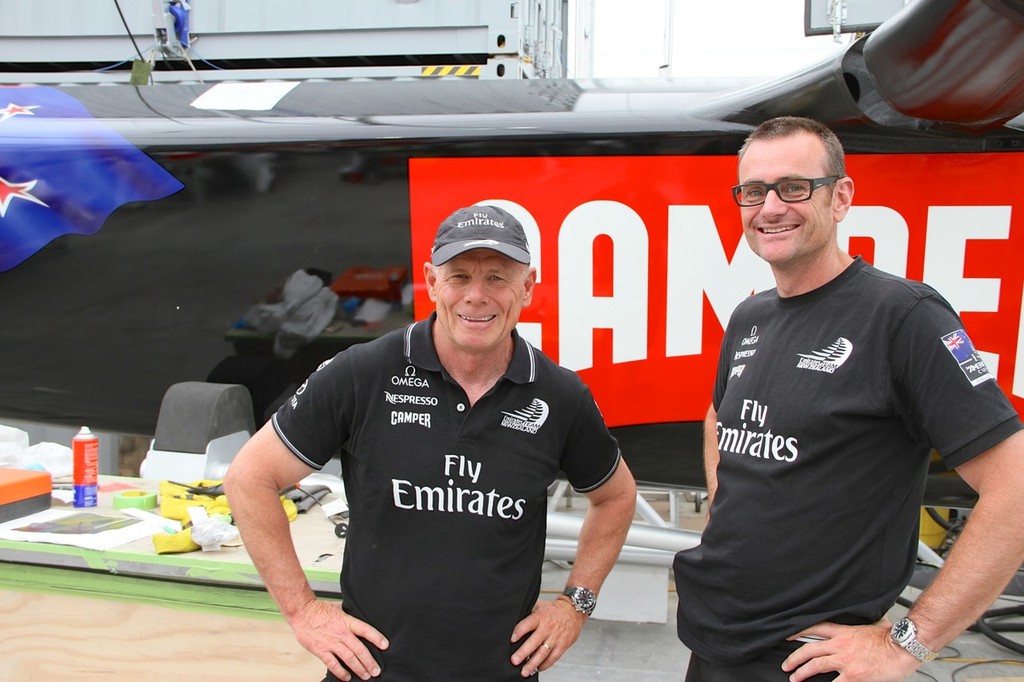America's Cup- The Wing is the Thing for Emirates Team NZ's next AC72
by Richard Gladwell on 18 Jan 2013

Grant Dalton (left) and Nick Holroyd in front of the new AC72 - Emirates Team NZ - Media Day January 17, 2012 Richard Gladwell
www.photosport.co.nz
Emirates Team New Zealand are on target to launch their second AC72 catamaran, around February 4, with their Challenger for the 34th America’s Cup having her first sail on February 7.
Doors at the teams base were thrown open for the New Zealand media today, showing the 72ft catamaran, with hulls in place, beams fitted and in an advanced state of preparation.
The hulls had only arrived from the Cookson Boats yard on Monday and four days later the beams had been fitted along with the other elements of the Y-structure which takes the loads and stresses from the yacht which is capable of sailing at over 40knots.
The differences from the team’s first AC72 were hard to spot – consistent with the theme that this design would be an evolution of the first rather than a completely new concept. In fact the design was locked off a few days after the launch of the team’s first AC72, in mid-July 2012. That first boat has since been decommissioned after sailing for the maximum 30 days allowed before the January 31, 2013 limitation prescribed by the Protocol for the 34th America’s Cup - ostensibly as a cost saving measure.
Although team principals would not be drawn on the precise nature of the changes, they did concede they were a number of small changes, which would make the second boat more efficient, resulting in faster speeds, stronger apparent wind and an all round better performer.
Eyes only zone
It is in the shed next door where the 40 metre tall wingsails are being built, that the real changes are being implemented. Cameras were barred, and media carefully chaperoned around the wing sails, in contrast to the relative free range permitted in the hull and platform assemble and fit-out area.
Boat 2 will be launched with the wingsail from Boat 1. That wingsail is being worked over completely by a team of 20 builders, in both a maintenance and upgrade exercise.
'We go back into the water with Wing 1, then we turn to Wing 2, which is half built', explains Emirates Team NZ MD, Grant Dalton. 'Then we go to Wing 2.'
'In the end they will be mirrors of each other, so we can switch them in and out if we have to.'
In response to a question as to whether the profile shape of the second wing will be different from the first, Dalton replies 'they will be the same profile, but the profile is changing.'
The team will use only two wings in contrast to both the Defender, Oracle Team USA and the Challenger of Record, Artemis Racing (SWE) who have both smashed their first wingsails, and will be building the full allowed quota of three wingsails.
'They will be so interchangeable the guys won’t even know which one is in the boat,’ chips in Technical Director, Nick Holroyd.
In fact the objective with the wingsails is that if one is totally destroyed before the start of one race, the second will hopefully be able to be fitted in time for the boat to race in the second race of the day. 'They are just sitting there, ready to go,' says Dalton.
Turning to the other AC72’s, Dalton says they don’t know what Artemis Racing’s second wingsail will be like. 'Oracle’s wing is different. Its sectional shape is a little different, but it is more in its ratio that it is quite different, in terms of its flap to front element ratio. It looks really clean. It looks like a really nice wing.
'We don’t know what their third wing is like, but based on the timeframe they had available we can’t imagine that it will be much different from their second. You just don’t have the time available to do any re-design.'
Big hours for design and build
Holroyd explains that there is about 20,000 hours involved in building a wingsail – 'to put that in perspective, it’s the build time of an IACC boat (used in the past five America’s Cups). That’s just hours to build, for design we have three aero-dynamists working on it, and another five on the mechanical drawings and structure and composite design work. It is not far of a third of our design team working on the wingsails for almost two years now.
'There are 15-18 man years of design work in this wingsail'
'There’s a huge number of components, plus the weight budget is very tight, and even more so with the wingsail, because the weight is up high', he adds.
'The wingsails are designed for the San Francisco weather bell-curve, which centres on 15-16kts. Your ability to twist the wing and de-power it is very, very important. If you were running these boats in Valencia, Spain you might look at a three element, two slot type of wingsail. This wingsail package is very much tailored to the winds that we are expecting in San Francisco.'
In response to questions about the top wind strength in which the AC72 is designed to be able to race, Holroyd says that 'is the subject of wild debate amongst the Challengers.
'All the Challengers have been pushing right the way through to lower the 33kt limit that has been in the Protocol. I suspect we might see a little more flexibility from the Defender on that point in the coming months', he adds with a wry smile.
For TVNZ's Martin Tasker's report http://tvnz.co.nz/sailing-news/team-nz-s-second-ac72-running-ahead-schedule-5320522/video?vid=5320487!click_here
And for 3News Ashlee Tulloch's report http://www.3news.co.nz/Team-NZ-unveil-second-boat/tabid/415/articleID/283471/Default.aspx!click_here
If you want to link to this article then please use this URL: www.sailworldcruising.com/105686